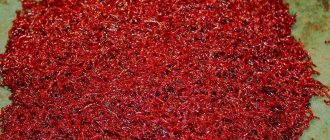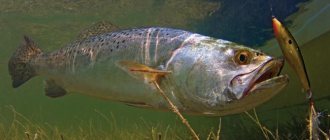The benefits of salted fish
Well, what could be the benefit of this salty product, you say?
And you will be wrong. Salt kills all microorganisms, making the fish absolutely safe to eat. At the same time, the fish is not subjected to heat treatment, which preserves all the vitamins, fats and minerals. Dried fish has been proven to kill some cancer cells, which is why the product is used to treat cancer. Fish contains a lot of omega-3 fatty acids, which affect brain function. Regular consumption of fish reduces the risk of senile dementia, improves performance, and increases brain activity. Eating dried and dried fish reduces the risk of heart attack and stroke and improves the functioning of the heart muscle. By replenishing omega-3 fatty acids and eating dried fish, pregnant women reduce the risk of premature birth. After a fish diet, very calm children are born who are not deficient in many vitamins.
Dried bream: salting at home - a recipe for salting and drying large fish without gutting
To get delicious dried bream at home, you need to go through several steps:
- Preparing bream for salting,
- Salting fish using dry salting method,
- Soaking the fish after salting
- Drying and drying bream
How to properly prepare bream before salting
First of all, after bringing your catch home, all the fish must be cooled. Put it in the freezer for a couple of hours.
This way your fish will be reliably preserved and odorless. And with this cooling we will get rid of some parasites if they are present in the fish.
How to properly salt bream for drying at home
Salting bream is not difficult. It is necessary to start salting with large individuals.
Next, we proceed to salting the bream. To do this, you first need to select the container size you need.
Ikea and other mega-superstores sell plastic boxes with handles. They are just perfect for salting bream - large and deep.
First of all, pour some salt into the bottom of the box. Then we fill the gills with salt, since it is from the head that the fish begins to spoil (as you and I know well).
Some immediately remove the gills and make an incision in the abdominal part so that the fish is better salted. But I assure you that it will be salted just fine anyway.
Next, we lay all the fish in layers “jack” (that is, head to tail, tail to head). Don't forget to sprinkle each layer with a little salt.
When all the bream is laid, take a piece of plywood or a board of the required size and place it on top of the salted fish. We press down with our weight and place pressure on top (load - the more fish, the heavier the load).
We put it in the refrigerator for a week - no less, or even 10 days. You can spend the first two days so that the fish gives juice without putting pressure on it. But every day you need to take the fish out of the refrigerator and press it again. This is necessary so that all the air inside comes out.
I don’t do quick salting, because it seems like the fish will pick up salt in a couple of days, but fermentation of the meat will not occur and it won’t be the same dried bream like store-bought.
If there is a lot of fish, then some can be left for drying and drying, and the rest can be packed in bags and placed in the freezer. And if necessary, deliver several fish.
How to properly soak bream after salting
After salting, any fish must be thoroughly soaked. This is done so that the excess salt is removed and we do not end up with over-salted bream.
To soak bream you will need a larger container than for salting. You can set aside a bathroom in your apartment for this (if your spouse and all household members do not mind).
First, we wash each bream under the tap. Then we place it on the bottom of the bath and fill it with cold water.
In the summer, when it is very hot, you should put a few pieces of ice in the fish bath.
The easiest way to dry and cure bream without gutting at home in summer and winter
You can dry bream in an apartment, but the best place, of course, is in a private house, where there is somewhere to hang all the fish.
Drying should be done in a cool and well-ventilated area. Small bream should be hung by the head, and large bream by the tail.
For a quick effect, especially in isolated places, such as an apartment, it is better to dry and dry the bream under a fan.
After drying, dried bream turns out to be very tasty without any odor, and when cut, the meat has an amber transparent color.
This is interesting: Carp on the grill - how to cook it, shish kebab recipes, what you can bake it with
Method 1: box
Let's look at how to store a battering ram at home if you have a dark, cool pantry or dry basement.
Step 1. Prepare everything you need to store dried fish
|
Step 2: Lay down the first layer
|
Step 3: Add Another Layer
|
| Step 4: Layer the fish in tiers to the top Continue working, alternating layers of product and newspaper in 2-3 layers |
Step 5: Cover the top layer with newspapers
|
Step 6. Put the container into storage
|
In an apartment or private house
In city housing, dried snacks are not stored anywhere except in the refrigerator. It emits a pleasant and appetizing aroma, but if it spreads throughout the entire apartment and permeates things and clothes with the smell of fish, no housewife will like it. Even if aromatic food is hung in the kitchen or on the balcony, it will not be able to be stored there for a long time due to unstable temperature conditions, and it is quite difficult to preserve the product from flies in the summer heat.
The refrigerator is an ideal place to hang fish, but only if nothing else is stored in it.
Although the fishy smell is good, it is not for cheese or butter, which will instantly absorb a specific aroma, despite the most intricate methods of packaging and separating products. In the refrigerator at an average temperature of about 5 degrees, a snack wrapped in kraft paper can be safely stored for 6 months.
Top articles: How to properly store sugar in 50 kg bags
Home storage does not involve purchasing tons of products, but you can make an impressive supply in the house:
Storing dried fish (photo source: Yandex.Pictures)
Fish can be placed in glass jars upside down if they are not longer than the container. The quality of a delicious snack will not change if the fish are gutted and the heads are cut off so that more product can fit into the jar. In order for proper preservation to take place without oxidation of the fish from access to oxygen, it does not turn yellow or rust, you need to place a small candle in the jar and set it on fire. Then, roll up the jar with a metal lid for canning, just like housewives roll up jam. An extinguished candle in a jar indicates a lack of oxygen in it, which is necessary for very long-term storage. If the temperature conditions are maintained, such storage can last for years without compromising the quality of the product. Special containers made of food-grade tin. The optimal container should have a perfectly tight or screw-on lid. The volume is not important, storage in the basement, cellar. The fish may or may not be gutted. If it’s large, lay it tightly in layers or set it upside down, and if it’s small, lay it in layers, each lined with thick or kraft paper. Place and light the candle before tightly closing the jar. Can be stored for about 8 months. In a vacuum. In recent years, special canning jars with lids and a pump for pumping out air have appeared on sale, that is, creating a vacuum without the use of a candle. Ideal for fish. Wooden boxes and tin boxes. In a wooden container, dried fish wrapped in paper and sheets of paper spaced one from the other can be stored for six months and does not dry out in winter.
An important condition is the absence of access to the container for rodents and insects. It is not allowed to replace paper with newspapers. In the freezer
For some reason, it is not customary to store dried fish in the freezer. But the method is effective and allows you to preserve the product for up to a year. Freezing does not change the taste, the fish does not dry out. On hooks. It is possible to store fish, wrapped so that it does not dry out, turn yellow or dry out, in double-layer gauze or in special bags made of linen fabric, suspended on hooks in a dark and dry basement. Duration: 2-3 months without change in taste. Dried fish should not be stored in plastic bags or plastic bags.
Storing fish in gauze (photo source: Yandex.Pictures)
In wooden boxes and burlap
It is convenient to store large quantities of fish in wooden boxes or baskets. It is better to cover containers with a large piece of cloth or gauze to prevent insects and pests from entering the product. Wrap each carcass in several layers of paper, place it without compaction in a basket or box and take it to the closet.
Instead of a box, you can use a linen bag. Should be stored at a humidity of no more than 70%, at a low temperature and in a ventilated place. In the same way, blanks can be stored in a cardboard box. The shelf life in this case is 1–2 months.
High humidity promotes the formation of mold, while low humidity will cause the product to dry out.
Storing dried fish
Many people believe that dried and dried products are the same thing. But this is a misconception, because... For each of them, a different cooking technology is used.
Today, two technologies for preparing dried semi-finished products are used:
- fresh drying;
- salty drying.
The process of salting fish for drying takes only a few hours, to obtain a dried product - several days. This is the main difference between fish delicacies.
Disputes often arise about how long and where it is better to keep it. There are several ways to store dried fish at home:
- The simplest and most affordable way is to wrap the product in cling film or paper and place it in one of the freezer compartments. After defrosting, the fish should be dried in a well-ventilated place for a couple of hours.
- You can store this delicacy in the refrigerator. Wrap in paper and place in the bottom compartment. The shelf life in this case is 6 months.
- If you have a large number of fish, it is advisable to use bulk containers - boxes made of cardboard or wood. The outside is covered with gauze or other natural fabric to prevent insects and dust from getting inside. Then a couple of sheets of paper are placed on the bottom. Lay out a layer of fish, cover it again with paper and repeat the layer until the very top. In a dry, cool and dark place with good ventilation, dried fish can be stored for 3 to 6 months.
- For short-term storage - about 1 month, the semi-finished product is wrapped in gauze or paper and hung on a thick thread in a shaded and cool room.
Storage in various containers
There is no space in the refrigerator, but you need to store a fairly large amount of dried delicacy at home - put the carcasses in a cardboard box, wooden box, placing each layer with thick paper. Cover the container with fabric that allows air to pass through. Place the boxes or drawers in a dark closet or another suitable room with good ventilation, maintaining the humidity indicated above. In such conditions, your favorite snack retains its taste for up to 6 months. If the period is exceeded, the fish darkens, becomes bitter, and the smell of old fish oil appears.
You can put the carcasses in a clean, dry jar (preferably made of tinted glass), place a piece of candle vertically between the fish, light it, and seal the jar hermetically. When all the oxygen has burned out and the candle goes out, take the containers to the pantry, basement - a room where it is dark and there is no dampness.
This unusual “preservation” will last up to 9 months, and if you keep it in the refrigerator, the period will increase to one year. When you don’t have a candle or the desire to tinker with it, but have alcohol, cover the bottom of a clean, dry glass container with it, then place the fish.
Experts say that the shelf life of the delicacy does not change and remains the same as when using a candle. Properly preserved dried fish is not only a tasty snack for beer, but also a healthy addition to the dinner table.
How to dry fish at home
Let's take a closer look at all the processes on how to properly dry fish at home.
Hanging methods
For drying, the fish must be hung. This can be done in two ways: by the tail or the head. A hole is made in the tail using a knife. This hole is used to attach the hook. In this position, all excess moisture from the abdomen flows out through the head. Thanks to this, the meat does not become bitter.
If the carcasses are hung by the heads, then a rope or wire is passed through the eyes. With this method, the fat will remain inside, and the meat will be slightly saturated with bile. As a result, the taranka will acquire a slight bitterness, which is appreciated among beer lovers.
The fish is hung on a rope made of natural materials, or a wire made of stainless material. During the drying process, carcasses should not touch each other.
Most often, the fish is first hung out in the sun to dry for 5-6 hours. Near this, garlands with fish are placed in a place where there is shade and a draft. If the weather is good outside, the fish dries out in three or five days.
If the air is too humid, then several transverse sticks are placed inside each carcass. This will allow the fish to dry faster.
The ideal place for drying fish is an attic with open windows. The fish will dry most quickly at a temperature of +18 to +20 C.
Drying areas
The places for drying fish are as follows:
Attic. The roof surface always warms up well. The carcass is not affected by either rain or sun.
Oven. First, the carcasses are heated in the oven for 2 hours. After this, each head is covered with foil, and the fish is left in the same conditions. After this, the fish is hung on the balcony, and the process continues for several more days.
Electric dryer. To prevent the fish from steaming and falling apart, you should not raise the temperature above 30°C.
On open air. Fish can only be dried in warm and sunny weather. When it rains or at night, the fish are removed indoors.
On the balcony. This room is suitable for drying even in damp weather.
It is very important to lay the floor and open the windows before starting the process.
When should you hang fish out to dry?
Sometimes they start hanging fish out to dry late in the evening so that they have time to dry a little. This way it attracts fewer flies.
There are fishermen who hang fish only in the sun during the day and bring them indoors at night. They claim that as a result of temperature changes, the fish becomes damp and loses its taste.
Also, sometimes the ram is hung in cool and damp weather. If it is well salted, it will not spoil. But under such conditions, the meat will dry out longer, but the taste of the fish will be much juicier and better.
How to deal with flies
Each carcass can be smeared with crushed garlic.
Lubricate the fish heads with sunflower oil.
Top articles: How long can mirror glaze be stored in the refrigerator
After the fish have been soaked, the carcasses are dipped in an acetic acid solution for 5-10 minutes. For 10 liters of water give 6 tablespoons of vinegar. This will repel insects, but at the same time reduce the taste of the ram.
The garland with fish is covered with gauze. This must be done so that the flies do not get to the fish. The gauze canopy is also sprinkled with vinegar or smeared with garlic.
In one container, mix vinegar (one part) and sunflower oil (three parts). This composition covers the surface of each carcass.
How and where to store dried fish at home
Taking into account simple storage recommendations, you can decide on the place where the fish will be stored. At home, you can choose several options that fit these criteria.
Suspended
You can keep carcasses hanging in a barn, pantry or attic. To prevent the product from drying out, first wrap it in baking paper. Wrap large varieties separately, and small ones - several pieces at a time. Hang supplies on string or hooks. In this form, the fish can remain fresh for 4 to 6 months. You don’t have to pack the product, but simply hang the fish at a distance of 3–5 cm from each other and cover with gauze.
Before eating, to protect yourself, check the quality of the fish.
Vacuum packed
It is not recommended to place dried fish in a plastic bag, as condensation will collect inside and the carcass will become moldy over time.
An analogue of such storage will be vacuum packaging. Moisture will not collect inside due to the lack of oxygen, and the fish will last for at least several months, provided that it is kept in the refrigerator. Please note that fattier and less salty varieties will last less than leaner and saltier ones.
In a glass jar or container
The method works similarly to a vacuum, but does not require additional equipment. You will need any glass container with an airtight lid and a regular candle.
Procedure:
- If the fish is large, cut it into pieces.
- Place a little salt at the bottom of the container.
- Place the carcasses in the jar not too tightly.
- Place a lit candle in the center of the container.
- Screw the jar tightly.
- All oxygen remaining in the container will burn, and a vacuum will form inside.
- Place the container with the product in the refrigerator.
This storage option will help keep the fish fresh for about 12 months.
In a refrigerator
The refrigerator is the most suitable environment for storing dried fish. The optimal temperature regime is maintained here. The best place is the bottom shelf or vegetable drawer. To prevent other foods from absorbing the fishy smell, wrap the carcasses in baking paper. This way you can keep fish fresh for 6 months. The main thing is not to put the product in a plastic bag or leave it without wrapper at all.
In the freezer
Dried fish can last in the freezer for as long as possible, at least a year. Before putting the product in the freezer, portion it out so that you can only remove one portion from the freezer as needed. Before use, keep the carcasses in the room for 15–30 minutes.
In tin cans
This storage method has one significant disadvantage. Not everyone has a tin container with a tight lid of the required large size in their home. If you do have such a container, you can safely use it. Place all the carcasses in a jar. Cover tightly and place in the refrigerator. An airtight container will not allow excess oxygen to get inside, will protect it from sunlight and will not allow the fish to permeate the rest of the food in the refrigerator with a specific smell.
In foil
Foil does not allow air to circulate, which has a very bad effect on the quality of dried fish. Even after a short period of storage, carcasses can become moldy. It is strictly not recommended to wrap the product tightly in foil. If there is no other material where you can wrap the carcasses, make several holes in the foil with a fork or knife. This way you will provide the product with the necessary air circulation.
In a box or canvas bag
It is convenient to place dried fish in a box or canvas bag in a basement or closet. Wrap a basket or wooden box with natural fabric. Place a layer of fish and cover with tracing paper. Fill the entire container, covering each row with paper. Cover the top of the container with a cloth. The product can remain in this form for 3 to 6 months.
In brine
Prepare a strong salt solution. Cut large fish into portions, and remove the tails from small fish. Place the carcasses in a container and fill with brine. Close the container with a lid and place it in a cool place. Before use, soak the required number of carcasses and dry to the desired consistency.
In a cellar or closet
A cellar or basement is ideal for storing dried fish. Here the required temperature and humidity levels are fully observed, and there is no light. You can simply hang the carcasses on hooks or a rope, having previously packed them in paper or put them in a box covered with gauze or in a fabric bag.
On the balcony
For such purposes, a glazed balcony on the north side is suitable. The best option would be to pack the carcasses in baking paper and hang them on a rope. This way you will maintain the freshness of the product for 3 months.
On air
This storage method is suitable if you want to use the product within 3-4 weeks. After a month, the fish may lose freshness or turn from dried to dry. Hang the carcasses on ropes or hooks so that they are not exposed to sunlight. To protect them from insects, cover the bundle with gauze or pack it in a cotton bag.
Storing dried fish with vodka
Vodka kills harmful microorganisms and maintains the required level of humidity in the storage container. Using this method is very simple. Select a container with a tight lid of the required size and pour 50 g of vodka into the bottom. Place the carcasses in a container and close. Keep the jar or container of fish in a cool place away from sunlight.
How to store dried fish (taranka)
The word taranka comes from the name of one of the subspecies of carp - tarani. Nowadays this word refers to all dried fish. But in addition to the ram itself, roach and roach are used for drying. This is a small fish, but you can also dry larger fish - bream, perch, crucian carp, silver bream, goby, and even pike. Similar studies have not been carried out, but in our country ram is considered an excellent snack for beer. Moreover, there is even a kind of dispute about which fish is better - dried or dried. For most beer and taranka lovers, the best snack is dried taranka. Its preparation can take several weeks, but it can also last several days, depending on the recipe and the size of the particular fish. Simplified drying occurs in several stages. First, the fish is salted in brine (brine) and kept for 3-4 days, and then it is hung out in the open air for final drying. Large fish are cut and gutted for better drying.
How to preserve dried fish in the heat or on the train
Before a long trip in the hot season, take care of how you will store dried fish. You can preserve the freshness of the product for 3-4 days by freezing. First, place the carcasses in the freezer and wait until they are completely frozen. Then wrap it in foil or put it in a thermal bag.
Place the fish in a storage container and cover it with plastic containers with ice.
You can replace such containers with improvised means. For example, fill a clean baby diaper with water and freeze it. When the liquid turns into ice, wrap the carcasses in diaper and pack.
Features of drying fish in the cold season
For high-quality drying, you need warm, dry weather, so in winter and autumn you have to create it at home.
If we dry fish in the cold season, you need to know:
- After soaking, hang the fish over the bath to drain the fat;
- the best place for drying is a glazed loggia or balcony with slightly open windows;
- when drying in winter or autumn, only the dry salting method is suitable;
- Places near the radiator or above the stove are suitable;
- plus drying in the cold season - the absence of flies.
In winter it is difficult to cook fish well. Drying requires fresh cool air and low humidity, and during the heating season the apartments are very warm. The meat will dry out quickly, but will not have time to ripen.
Dried fish storage options
This product is traditionally considered resistant to time and external conditions. Unfortunately, this is not entirely true. If the products are left in the heat for a long time, they may dry out or go rancid. To prevent this from happening, you need to know how to store dried fish and where it is best to do it:
- In a refrigerator. The bottom shelf of the refrigerator is best suited for this purpose. We wrap the blanks in plain or wax paper and place them separately from other products. Even with this approach, the products will retain their condition for six months.
- In the freezer. Longest storage option. Before placing the components into the chamber, they must be wrapped in cling film. Defrosting fish is done naturally. After this, she may need additional drying during the day in the fresh air or at home.
- In banks. Modern housewives use two types of storing dried fish in glass jars. The first involves the use of alcohol. Pour some liquid into the bottom, lay out the products and close with a lid. The second requires creating a vacuum using a small candle. In both cases, it is recommended to use sterile containers.
In boxes. We equip containers made of thin boards or ordinary plywood with hooks from the inside, to which we attach a rope. We hang fish on it at a short distance from each other. We make slits or drill holes in the walls of the box to allow air movement. We do not use a lid, but cover the container with gauze. We store such structures in a cool place.
On air. This method is only suitable if the fish is not planned to be stored for more than a month. The room should be cool, ventilated and dark. Linen bags, rope or hooks are used to hang workpieces. In the latter cases, the products are additionally covered with gauze.
Even salt is not capable of preserving fish stocks in the desired condition for a long time. So, the faster they are eaten, the less likely it is that the product will unpleasantly surprise with its taste and aroma. Products put away for storage (if it is not a freezer) should be checked regularly. After all, missed mold will quickly spread throughout all elements, which can cause the entire stock to suffer.
Fans of dried fish buy it in large quantities. You need to know how to store it correctly. This is a perishable product, so it must be stored correctly.
There are several options for where to store dried roach:
- Suspended in a special way.
- In the freezer.
- In a wooden box.
- In a canvas bag.
- In a tin can.
Before storing smoked roach, you need to make sure that it is fresh and of high quality.
You should not find on it:
- Mold.
- Whitish coating.
- Traces of damage from bacteria.
- Unpleasant smell.
If there are defects in the skin of the fish, it should be discarded.
- How to store dried roach or ram hanging.
Dried fish should not be placed in plastic bags. It will quickly become damp and mold will appear on it.This method of preserving roach is more convenient for owners of country houses. Such houses have a basement or cellar. If you don’t have a country house with a basement, you can store the roach on the balcony.
Wrap the fish in three layers of paper. This is done so that it does not dry out. Wrap the resulting bundle with a strong thread on top and hang it on a hook.
The temperature in the room where the roach is stored should not be higher than +10 C. It is advisable that the basement be dark and not too humid. This is a convenient way to stock up on roach for the winter.
- Storing dried fish in the freezer.
A more convenient way to store dried fish is in the freezer. You need to wrap the fish in paper. And put it in the freezer. There it can be stored for up to 10 months. - Storage in a wooden box and in a canvas bag.
A convenient way to store dried fish is a wooden box. The product should be carefully placed there. The box must be well ventilated.But you need to cover it with a large rag. Otherwise, insects may crawl in there. You can also put the roach or ram in a canvas bag.
- Storage in a tin can.
Experts advise putting the roach in a jar, lighting a candle there and closing the lid tightly. The oxygen will evaporate and the candle will go out. This helps preserve all the taste of the fish.
We tried to consider all possible ways to store dried fish at home.
Storage and packaging of dried and dried fish
Category: Dried, dried and smoked fish products
For dried and dried fish, equilibrium humidity is important during storage. Knowing it, you can determine the relative humidity of the air.
Short-term storage of these goods is best carried out at a relative humidity of 65–80% and a temperature not exceeding 8 o C in darkened rooms.
Storing dried fish without special packaging leads to weight loss (shrinkage), and with high air humidity, the fish becomes moist and moldy. In addition, when stored in conditions of access to air, oxidative processes occur in the fat in fish, leading to a deterioration in the quality of the product.
It is better to store especially perishable dried, dried (hanging) fish, as well as ordinary fish intended for long-term storage at a temperature close to the freezing point, but not higher than -5 -8 o C. In such conditions, fish can be stored in packaging up to 1 year.
However, it should be remembered that dried fish is a seasonal product and should be sold before autumn.
The sharp difference in the humidity of goods of this group, as well as the relative humidity of the air in the places of storage and sale, does not make it possible to offer the same modes and periods of permissible storage.
It must be borne in mind that no other group of fishery products is capable of producing such a large actual loss, and, conversely, large surpluses can be obtained from this group.
When storing dried and dried fish, the following changes are possible: shrinkage, moisture, salt crystallization, mold, putrefactive spoilage, fat oxidation, change in consistency, pest damage.
Therefore, dried and dried fish must be stored in special packaging. For packaging, wooden boxes, corrugated cardboard boxes, wicker baskets, matting coolers, linen grocery bags, linen kenaf bags, multilayer paper bags (at least four layers), craft bags laminated with polyethylene, inventory containers (for local sales), cardboard packs, film bags, tin cans. It is allowed to use other types of containers and packaging that meet sanitary requirements. For example, studies have been carried out on the properties of such packaging materials as low-density polyethylene film (thickness 100–130 microns), polyethylene cellophane, kraft paper with one-sided polyethylene coating, aluminum foil laminated with polyethylene. Polyethylene-cellophane and foil laminated with polyethylene turned out to be of little use for packaging dried fish.
A significant disadvantage of polyethylene film as a packaging material for dried fish is its low resistance to mechanical damage from sharp parts of the fish. Therefore, it is advisable to use kraft paper with polyethylene
coating. The shelf life of dried roach in such packaging at a temperature of 0 o C is up to 5–6 months. The product retains its good appearance, normal consistency, pleasant taste and smell and remains at the I grade level in other respects. Fish stored under the same conditions in matting bags after 2.5–3 months. had a dull surface of the scales, salt protruding on the surface in places, dried out meat with the smell and taste of oxidized fat.
When packing dried roach in tin cans No. 14 (volume 3033 ml), preliminary cutting of the fish was proposed in order to more rationally use the container.
To do this, remove the head, caudal fin and part of the abdomen at the level of the end of the costal bones, as well as the insides, but leave the caviar. The yield of cut dried fish with caviar is on average 74% of its weight. Then the carcasses are pressed in a mold and placed in a tin can with a total weight of 1.5–1.6 kg. The capacity of the jar increases by 2 times compared to if uncut fish were placed in the jar. Experiments have shown that the storage of cut and uncut fish is the same. Noticeable signs of fat oxidation appeared after 10 months of storage.
Qualitative changes in the consistency of dried fish during storage can be assessed by the moisture absorption of muscle tissue. Higher moisture absorption is maintained in fish packaged in a polymer film to protect it from shrinkage; the consistency of the muscle tissue remains dense, juicy, and the product is easily chewed while maintaining its flavor and aromatic properties.
Overweight fish products (backs, sides, sides, layers, half-layers) are not allowed to be packed in bags and coolers to avoid damage.
When storing dried fish, processes of fat oxidation and darkening of meat occur. It must be stored at a relative humidity of no more than 70%. At an air humidity of 75%, mold fungi develop on the surface of dried fish, and at 90% or more, bacteria develop. Therefore, the most reliable way to protect the quality of dried fish products should be considered to be packaging them in vapor-tight packaging materials.
What's the best way to store dried fish at home?
Before deciding how to store dried fish, determine its quality. If there is mold on the surface, an unpleasant odor emanates from the carcass, or even worse, worms have appeared inside, immediately get rid of the product. High-quality dry fish will be intact and without damage, its scales will be smooth and shiny, and the product will have a characteristic fishy smell.
In the freezer
Dried fish will last in the freezer for as long as possible – at least 12 months. To preserve the freshness and taste of the product, before putting it in the freezer, divide all the carcasses into portions and pack them in paper. This way you can take as many hazel grouse for consumption as you can eat at one time.
Top articles: How to pickle milk mushrooms so that they are crispy and tasty: recipes
In a refrigerator
The best place for dried fish is the middle shelf of the refrigerator. Wrap the carcasses in paper before storing. This way you will better preserve its freshness and protect other products from the fishy smell. The batter can last no more than 6 months in the refrigerator.
In boxes or jars
The main criteria for this storage method are optimal temperature and humidity. You can ensure such conditions by placing the container with the battering ram in the refrigerator, basement or closet. Like dried fish, you can place dried fish in a glass container and tightly close the lid, removing the oxygen inside with a burning candle. You can also put the carcasses in a wooden or cardboard box with holes for ventilation.
How to store different varieties of dried fish
Flounder, bream, ide or roach will remain fresh during short-term storage of up to 30 days if the following are observed:
- temperature range: from +3 to +8 degrees;
- optimal humidity equal to 65–80%;
- packaging standards (paper or fabric, but not polyethylene);
- light regime, or, to be more precise, its absence.
Please note that a low level of humidity will cause the carcasses to dry out, and a high level will cause mold to appear on their surface. For long-term storage of roach, bream, ide or flounder, use vacuum packaging, glass containers or tin cans
Keep the container with the product on the middle shelf of the refrigerator. For longer storage, you can put the carcasses in a box and put them in the cellar, or package them and place them in the freezer.
For long-term storage of roach, bream, ide or flounder, use vacuum packaging, glass containers or a tin can. Keep the container with the product on the middle shelf of the refrigerator. For longer storage, you can put the carcasses in a box and put them in the cellar, or package them and place them in the freezer.
How long can dried fish be stored?
The period during which dried fish will definitely not lose freshness is determined by the nature of the conditions of the environment where it is located. For example, carcasses will be stored:
- in the freezer - at least 12 months;
- in the refrigerator - no more than 6 months;
- in a jar in a cool, dark place – about 12 months;
- in a box in a basement or cellar - approximately 8 months.
The specified periods can be significantly reduced if at least one of the storage conditions is violated.
Is storing dried fish different from dried fish?
Before answering this question, it’s worth understanding exactly how dried fish differs from dried fish. Each variety has its own preparation rules and storage requirements.
The differences between varieties are presented in the table.
| Dried | Dried |
| It can be either fresh or salty. | It only comes in salty form. |
| It can be prepared both in air and in the oven. | Dry only in the fresh air. |
| Cooking time in the oven takes only 5–6 hours, and in the air from 40 to 60 days. | Production time is 14–21 days. |
| Cooked without salt requires additional processing. | Immediately ready to eat. |
| Fatty varieties. | Lenten varieties. |
Rules for storing dried fish
Before storing the product, make sure that its quality meets the freshness criteria. An unpleasant odor or fungus on the surface will help you understand that the product is stale.
Storage conditions:
- do not expose the product to sunlight;
- the temperature in the storage area should not exceed +10 degrees, otherwise the fish will quickly deteriorate;
- do not let the carcasses dry out, the optimal humidity is 70–80%.
Under what conditions can dried fish be stored?
You can keep dried fish in suitable conditions from 1 week to 12 months. In this case, observe the main storage criteria:
- keep the product in a dark place;
- provide containers with carcasses with sufficient ventilation;
- adjust the humidity level in the room to 60–70%;
- Monitor the temperature, ideally if the temperature at the storage location is 3–10 degrees.
Please note that for best preservation, it is better to pack dried varieties before storage.
Features of drying different varieties
Recipes for cooking different types of fish have their own characteristics, since the raw materials differ in size, fat content and elasticity of the pulp.
| Variety | Calorie content, kcal/100g | Drying time, days | Peculiarities |
| Carp | 184 | 14 | You need to take fatty carcasses, be sure to gut them, and cut large specimens along the ridge. You can leave the head if you wish. |
| Vobla | 235 | 10-12 | The roach must be dried ungutted. The belly of a small one should be cut, and the back of a large one. It is better to salt the roach in brine with its backs up under pressure. |
| Pink salmon | 185 | 7-10 | The flesh of pink salmon has medium fat content, so it will make an excellent balyk. |
| Zander | 85 | 10 | Salting river fish is simple and very quick. The pike perch will taste best if you add a little dill, parsley or black peppercorns to the brine. |
| Ide | 118 | 10 | It is best to cook ide in the autumn, since at this time it gains its first fat and will turn out the most delicious. |
| Bream | 220 | 7 | The pulp is especially fatty and tasty with a high calorie content. For drying, it is better to choose medium-sized fish, and from large ones you should make balyk. |
| Blue whiting | 255 | 7 | It is better to salt blue whiting with salt and sugar, pepper and bay leaves. |
| Trout | 185 | 6-7 | Red fish makes a savory delicacy for sandwiches. It is better to cook trout in pieces. |
| Roach | 149 | 10 | The taste of roach is similar to roach or trout. It is best to dry roaches in the spring, so that the carcasses do not have time to become saturated with the smell of mud and remain tasty and fatty. |










